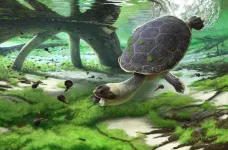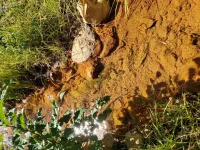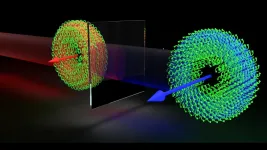(Press-News.org) Joyce WG, Rollot Y, Evers SW, Lyson TR, Rahantarisoa LJ, Krause DW. 2021. A new pelomedusoid turtle, Sahonachelys mailakavava, from the Late Cretaceous of Madagascar provides evidence for convergent evolution of specialized suction feeding among pleurodires. Royal Society Open Science 8:210098. https://doi.org/10.1098/rsos.210098
First author: Prof. Dr. Walter Joyce (walter.joyce@unifr.ch), Professor of Paleontology, University of Fribourg, Switzerland
Co-authors:
- Yann Rollot (yann.rollot@unifr.ch), PhD student, University of Fribourg, Switzerland
- Serjsocha Evers (serjoscha.evers@unifr.ch; preferred: serjoscha.evers@googlemail.com), Postdoctoral Researcher, University of Fribourg, Switzerland
- Tyler Lyson (Tyler.Lyson@dmns.org), Associate Curator of Vertebrate Paleontology, Denver Museum of Nature and Science, USA
- Lydia Rahantarisoa (ralyhanta@yahoo.fr), Professor of Geology, Université d'Antananarivo, Madagascar
Senior author: David Krause (David.Krause@dmns.org), Senior Curator of Vertebrate Paleontology, Denver Museum of Nature & Science, USA
Figure details
Fig. 1 Life reconstruction of Sahonachelys mailakavava, preying upon tadpoles of the giant Madagascan frog Beelzebufo ampinga using specialized suction feeding. Artwork by Andrey Atuchin.
Fig. 2 Fossil of Sahonachelys mailakavava, showing the preserved skull parts.
Fig. 3 Fossil of Sahonachelys mailakavava, showing the preserved shell.
Content and importance
We here describe a new species of pelomedusoid turtle from a geological formation in Madagascar otherwise known for its exquisitely preserved fossil birds, dinosaurs, crocodilians, and mammals. The new turtle possesses an unusually flattened skull combined with a particularly gracile lower jaw and enlarged tongue bones (hyoids), which not only gave it a frog-like appearance, but also suggests that it was adapted to a specialized feeding mode called suction-feeding.
Suction feeders open their mouths rapidly to suck in prey items under water, which is in contrast to other subaquatic feeding modes in which animals shoot their heads forward to reach for prey. The new turtle has several modifications in its head skeleton that show that it was well suited for suction feeding: its skull is low but wide, and the jaws are strongly bowed and angled forward, which creates a strongly rounded mouth opening that is physically beneficial for creating large suction forces. The tongue bones are strongly developed, and this hints at large muscles that pulled the tongue skeleton backwards and opened the esophagus during the strike at prey - again creating more suction. As in all modern turtles, the new species lacks teeth, but in addition the surfaces at the upper and lower jaws that face toward each other are poorly developed, showing that this turtle did not use its jaws to process food, but instead swallowed prey whole, which is typical for suction feeders. We hypothesize that the turtle fed on small-bodied living prey, such as insect larvae, fish fry, and tadpoles using quick strikes. We, therefore, name the new species Sahonachelys mailakavava, which means "quick-mouthed frog turtle" using Malagasy and Greek words. Special about the turtle is also its preservation: it is known from a nearly complete skeleton, despite its small body size, barely more than a foot long.
Turtle fossils often come either as shells or skulls that have been separated from one another; for many extinct turtles, we only either one or the other, but not both. Having a complete skeleton helps us to understand the whole animal, and also makes it possible to compare it to other turtle fossils, regardless of how these are preserved. Based on such comparisons, we constructed a family tree of turtles that shows that Sahonachelys mailakvava was an early relative of podocnemidid turtles, which today are native to Madagascar and South America, but which were more widespread in the past.
The palaeontological fauna of Madagascar is known for animals that are very specialized, which is in part due to its long isolation from surrounding continents. Our turtle shows that the Madagascan fauna was already unique in the Late Cretaceous: Sahonachelys mailakavava is the only representative of its group to have evolved suction-feeding, which is otherwise only known in distant relatives, so-called snake-necked turtles.
Quotes by the authors:
"This is the best-preserved turtle of the entire Late Cretaceous of the southern continents and as such very significant in terms of reconstructing its way of life and relationships with other turtles" (Prof. Walter Joyce, first author of study)
"As palaeontologists, we try to understand the biology and evolution of past life. Fossils like this give a wealth of information that is not always present. The identification of suction feeding in a new turtle lineage is exciting and was unexpected. It shows how animals evolve similar traits for similar functions, even if they are only distantly related." (Serjoscha Evers, co-author of study)
"Sahonachelys is a stunning example of evolution in isolation. It represents a lineage that evolved on Madagascar for over 20 million years and joins a litany of other bizarre Late Cretaceous vertebrate animals that we've found on the island. This specimen is, by far, the best turtle fossil we discovered during the 28 years of conducting field research there." (David Krause, co-author of study)
A new pelomedusoid turtle from the Late Cretaceous of Madagascar discovered
A new pelomedusoid turtle from the Late Cretaceous of Madagascar provides evidence for convergent evolution of suction feeding among pleurodires.
2021-05-05
ELSE PRESS RELEASES FROM THIS DATE:
New algorithm uses a hologram to control trapped ions
2021-05-05
Researchers have discovered the most precise way to control individual ions using holographic optical engineering technology.
The new technology uses the first known holographic optical engineering device to control trapped ion qubits. This technology promises to help create more precise controls of qubits that will aid the development of quantum industry-specific hardware to further new quantum simulation experiments and potentially quantum error correction processes for trapped ion qubits.
"Our algorithm calculates the hologram's profile and removes any aberrations from the light, which lets us develop a highly precise technique for programming ...
New app makes Bitcoin more secure
2021-05-05
A computer science engineer at Michigan State University has a word of advice for the millions of bitcoin owners who use smartphone apps to manage their cryptocurrency: don't. Or at least, be careful. Researchers from MSU are developing a mobile app to act as a safeguard for popular but vulnerable "wallet" applications used to manage cryptocurrency.
"More and more people are using bitcoin wallet apps on their smartphones," said Guan-Hua Tu, an assistant professor in MSU's College of Engineering who works in the Department of Computer Science and Engineering. "But these applications have vulnerabilities." ...
Neighborhood disadvantage may be an environmental risk factor for brain development
2021-05-05
A new USC study suggests that certain neighborhoods - particularly those characterized by poverty and unemployment - may pose an environmental risk to the developing brains of children, impacting neurocognitive performance and even brain size.
The research was published May 3 in the journal JAMA Pediatrics.
These findings highlight the importance of neighborhood environments for child and adolescent brain development, the researchers said, and suggest that policies, programs and investments that help improve local neighborhood conditions and empower communities could support children's neurodevelopment and long-term health.
"This is the first large, national study ...
New application of AI just removed one of the biggest roadblocks in astrophysics
2021-05-05
Using a bit of machine learning magic, astrophysicists can now simulate vast, complex universes in a thousandth of the time it takes with conventional methods. The new approach will help usher in a new era in high-resolution cosmological simulations, its creators report in a study END ...
Long-term monitoring shows successful restoration of mining-polluted streams
2021-05-05
Many miles of streams and rivers in the United States and elsewhere are polluted by toxic metals in acidic runoff draining from abandoned mining sites, and major investments have been made to clean up acid mine drainage at some sites. A new study based on long-term monitoring data from four sites in the western United States shows that cleanup efforts can allow affected streams to recover to near natural conditions within 10 to 15 years after the start of abatement work.
The four mining-impacted watersheds--located in mountain mining regions of California, Colorado, Idaho, and Montana--were all designated as Superfund sites under the Comprehensive Environmental Response, Compensation, and Liability Act (CERCLA), which helps ...
Machine learning accelerates cosmological simulations
2021-05-05
A universe evolves over billions upon billions of years, but researchers have developed a way to create a complex simulated universe in less than a day. The technique, published in this week's Proceedings of the National Academy of Sciences, brings together machine learning, high-performance computing and astrophysics and will help to usher in a new era of high-resolution cosmology simulations.
Cosmological simulations are an essential part of teasing out the many mysteries of the universe, including those of dark matter and dark energy. But until now, researchers faced the common conundrum of not being ...
Without commuter traffic, pandemic-era drivers are speeding up, increasing noise pollution
2021-05-05
As pandemic lockdowns went into effect in March 2020 and millions of Americans began working from home rather than commuting to offices, heavy traffic in America's most congested urban centers--like Boston--suddenly ceased to exist. Soon afterwards, the air was noticeably cleaner. But that wasn't the only effect. A team of Boston University biologists who study how human-related sounds impact natural environments seized the opportunity to learn how the reduced movement of people would impact local ecosystems. They found--surprisingly--that sound levels increased in some nature conservation areas, a result of cars driving faster on roads no longer choked by traffic.
BU ecologist Richard Primack and Carina Terry, an undergraduate student working in Primack's ...
UMD team demonstrates swarm of photons that somersault in lockstep
2021-05-05
Spinning or rotating objects are commonplace, from toy tops, fidget spinners, and figure skaters to water circling a drain, tornadoes, and hurricanes.
In physics, there are two kinds of rotational motion: spin and orbital. Earth's motion in our solar system illustrates these; the daily 360-degree rotation of Earth around its own axis is spin rotation, while Earth's yearly trip around the sun is orbital rotation.
The quantity in physics defined to describe such motion is angular momentum (AM). AM is a conserved quantity: given an initial amount of it, it can be broken up and redistributed among particles such as atoms and photons, ...
A trait of the rare few whose bodies naturally control HIV: "trained" immune cells
2021-05-05
BOSTON -- Immunity often calls to mind the adaptive immune response, made up of antibodies and T cells that learn to fight specific pathogens after infection or vaccination. But the immune system also has an innate immune response, which uses a set number of techniques to provide a swift, non-specialized response against pathogens or support the adaptive immune response.
In the past few years, however, scientists have found that certain parts of the innate immune response can, in some instances, also be trained in response to infectious pathogens, such as HIV. Xu Yu, MD, a Core Member of the Ragon Institute of MGH, MIT and Harvard, and colleagues ...
Being around children makes adults more generous
2021-05-05
Adults are more compassionate and are up to twice as likely to donate to charity when children are present, according to a new study from psychologists.
The research, conducted by social psychologists at the University of Bath and Cardiff University and funded by the Economic and Social Research Council (ESRC), examined how the presence of children influences adults' compassionate motivations and behaviours.
Across eight experiments and more than 2,000 participants, the researchers asked adults to describe what typical children are like. After focusing on children in this way, participants ...
LAST 30 PRESS RELEASES:
Statins significantly reduce mortality risk for adults with diabetes, regardless of cardiovascular risk
Brain immune cells may drive more damage in females than males with Alzheimer’s
Evidence-based recommendations empower clinicians to manage epilepsy in pregnancy
Fungus turns bark beetles’ defenses against them
There are new antivirals being tested for herpesviruses. Scientists now know how they work
CDI scientist, colleagues author review of global burden of fungus Candida auris
How does stroke influence speech comprehension?
B cells transiently unlock their plasticity, risking lymphoma development
Advanced AI dodel predicts spoken language outcomes in deaf children after cochlear implants
Multimodal imaging-based cerebral blood flow prediction model development in simulated microgravity
Accelerated streaming subgraph matching framework is faster, more robust, and scalable
Gestational diabetes rose every year in the US since 2016
OHSU researchers find breast cancer drug boosts leukemia treatment
Fear and medical misinformation regarding risk of progression or recurrence among patients with breast cancer
Glucagonlike peptide-1 receptor agonists and asthma risk in adolescents with obesity
Reviving dormant immunity: Millimeter waves reprogram the immunosuppressive microenvironment to potentiate immunotherapy without obvious side effects
Safety decision-making for autonomous vehicles integrating passenger physiological states by fNIRS
Fires could emit more air pollution than previously estimated
A new way to map how cells choose their fate
Numbers in our sights affect how we perceive space
SIMJ announces global collaborative book project in commemoration of its 75th anniversary
Air pollution exposure and birth weight
Obstructive sleep apnea risk and mental health conditions among older adults
How talking slows eye movements behind the wheel
The Ceramic Society of Japan’s Oxoate Ceramics Research Association launches new international book project
Heart-brain connection: international study reveals the role of the vagus nerve in keeping the heart young
Researchers identify Rb1 as a predictive biomarker for a new therapeutic strategy in some breast cancers
Survey reveals ethical gaps slowing AI adoption in pediatric surgery
Stimulant ADHD medications work differently than thought
AI overestimates how smart people are, according to HSE economists
[Press-News.org] A new pelomedusoid turtle from the Late Cretaceous of Madagascar discoveredA new pelomedusoid turtle from the Late Cretaceous of Madagascar provides evidence for convergent evolution of suction feeding among pleurodires.






